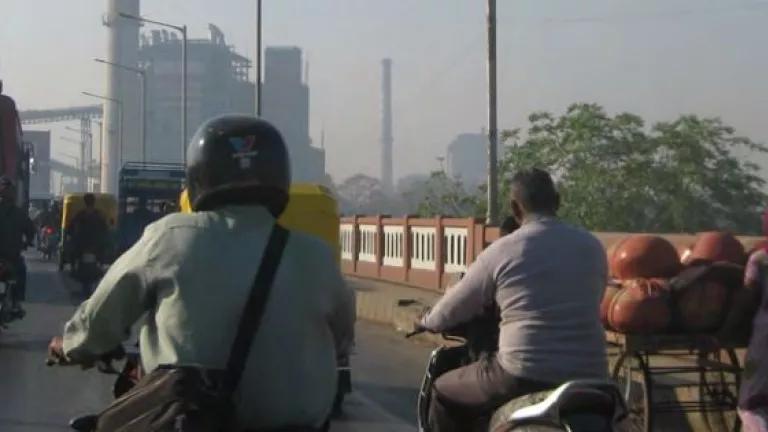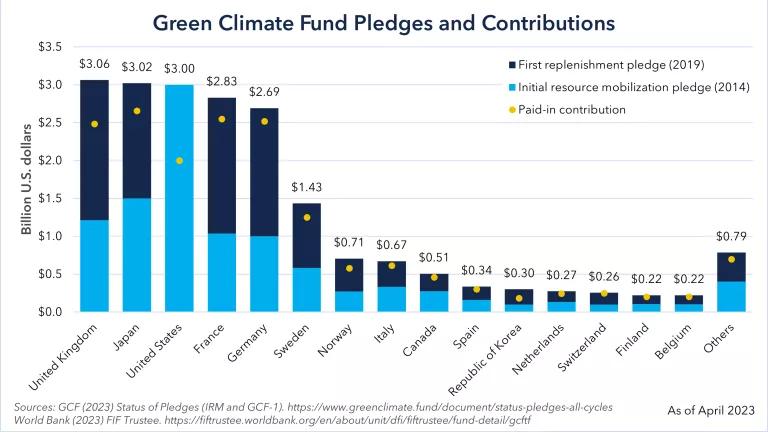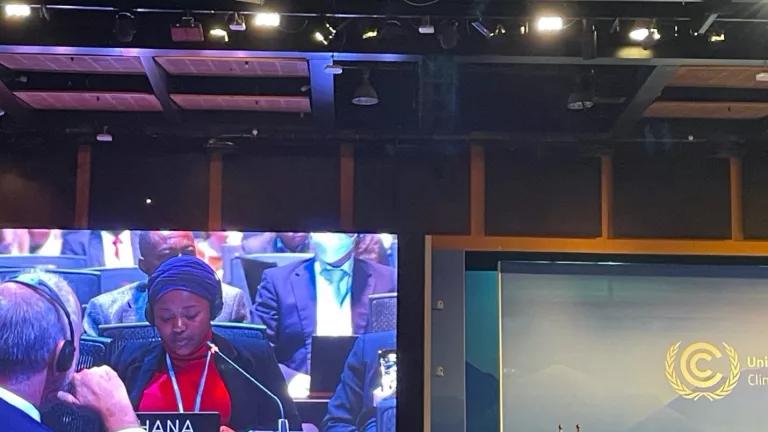Progress on Global Cooling as Global Warming Talks Close
Sustainable cooling was among the hottest topics on the agenda at COP28, with several groundbreaking announcements for action.

All images courtesy of NRDC
This blog was co-authored with Ashish Jindal, who leads NRDC's work on energy efficiency and cooling in India.
With the planet rapidly heating up, cooling has been a hot topic at the United Nations Climate Change Conference (COP28) in Dubai last week, where nearly 100,000 delegates from 200 countries agreed finally to transition away from fossil fuels to keeping the global temperature rise to less than 1.5 degrees Celsius.
Another top highlight was the release of the Global Cooling Pledge: 63 countries agreed to cut their emissions from cooling systems by 68 percent by 2050 (compared to 2022 levels), as well as committing on a suite of other targets, including establishing minimum energy performance standards by 2030. With this pledge, cooling is now firmly on the global climate agenda. Access to cooling is a matter of life and death for billions of people exposed to extreme heat: In addition to providing basic comfort, cooling is essential to delivering vaccines and medicines safely, providing health care, and minimizing food waste. Air conditioners (ACs), common in affluent homes and buildings, are merely an aspiration for those with less privilege. At the heart of it, access to cooling is emblematic of global inequity.
At the climate talks, three main cooling-related issues were under discussion:
- How do we provide cooling comfort without using too much electricity?
- How do we phase down refrigerants that are thousands of times worse than carbon dioxide, which many of these appliances use and switch to better alternatives?
- How do we build and strengthen resilience to extreme heat in our communities, especially those most vulnerable to climate impacts?
Below is an analysis as well as key takeaways from each of these three questions from NRDC side events at COP28.
Energy-efficiency and cooling
Fulfilling cooling requirements in a warming world will require rapid innovation across sectors: space cooling, transport, and cold chain. Passive cooling solutions—such as building designs that include shading, cool and reflective roofs, green spaces—as well as improving the energy efficiency of heavy electricity-consuming appliances such as room ACs, refrigerators, and ceiling fans will be essential. Implementing these innovative climate-friendly cooling strategies could not only increase comfort but also cut eight years’ worth of global emissions. Meeting future cooling needs sustainably can also reduce the cost of renewable energy build out by $3.5 trillion by 2030.
For countries such as India in the Global South, cooling efficiency is central to meeting future cooling needs. India’s National Cooling Action Plan highlights that the energy needed to cool buildings, vehicles, and food systems is projected to grow exponentially to about eight times its current levels by 2038. Estimates indicate that refrigerator and AC ownership numbers in India are set to explode. As temperatures rise with per-capita incomes—and as people search for ways to adapt to heat stress—India is expected account for more than a third of the world’s AC sales in the decades to come. The challenge is to match the speed and scale of developing and implementing innovative and sustainable cooling solutions with the growing demand.
The technologies of the past cannot be used to cool the future: This was the key takeaway at the official UNFCCC side event on Global Collaboration on Innovation in Sustainable Cooling: Solutions for Market Transformation, hosted by NRDC in partnership with The Energy and Resources Institute, India and New Energy and Industrial Technology Development Organization, Japan. Experts shared updates on ongoing work on innovative cooling technologies such as the 5X less climate impact air conditioner; Hitachi’s innovations in space conditioning; opportunities in technological innovations in ACs and ceiling fans; and more. Ali Zaidi, the United States’s national climate advisor, highlighted the importance of addressing equity issues, financial burdens, and the broader environmental context to ensure fair and effective global solutions for cooling challenges.
Switching to climate-friendly refrigerants
Traditionally, air-conditioning and refrigeration systems use chemicals called hydrofluorocarbons (HFCs) to produce the cooling effect. However, HFCs have a global warming potential hundreds to thousands of times that of CO2 on a kilogram-for-kilogram basis. The world had already agreed to phase down harmful refrigerants as a part of Montreal Protocol, the global treaty that helped save the ozone layer. At the 35th meeting of the parties to the Montreal Protocol, which concluded in October this year in Nairobi, the parties agreed to nearly double the funding to $965 million to help developing countries switch to climate-friendly refrigerants. This year, the two climate impacts of cooling came together, with the first Montreal Protocol Pavilion, called Ozone to Cool Zone, at COP28.
The Ozone to Cool Zone pavilion hosted an extensive program seeking and presenting solutions that minimize the cooling sector's negative climate impacts, advance its sustainability goals, and unlock innovation for more effective solutions. As part of the program of events at the Montreal Protocol Pavilion, NRDC and The Council on Energy, Environment and Water hosted a discussion on the industry perspective on manufacturing ecosystem, markets, and policies to cool India’s billions.
Industry in India is playing a crucial role in refrigerant transitions through various interventions. At the event, industry experts highlighted that they are investing in and adopting sustainable cooling technologies, low global-warming-potential refrigerants, and passive cooling and energy efficient cooling systems. Industries are also focused on the growth of a skilled workforce in the sustainable cooling sector. This includes training programs and partnerships with educational institutions to ensure that there is a pool of talent available to drive the transition. The private sector is looking at adopting circular economy practices, such as recycling and reusing cooling components, that can minimize waste and reduce the environmental footprint of cooling systems.

Experts at a side event to discuss cooling India’s population
Building resilience to extreme heat
Extreme heat exposure is already a public health emergency in many countries and continues to worsen with each passing year. Extreme heat events have inequitable impacts, with low-income workers feeling the biggest impacts. As extreme heat events become more common and last longer, interventions that build resilience and solutions that ensure access to cooling will only become more critical.
To discuss this, NRDC, Energy Efficiency Services Limited, and the United Nations Climate Global Innovations Hub hosted an event on innovative solutions for building resilience to extreme heat and promoting access to cooling solutions at COP28. India’s national disaster management authority (NDMA) shared their experience with preparedness mechanisms to extreme heat, as well as the country’s focus on long-term heat mitigation measures. These actions include national-level heat wave preparation guidelines, as well as support for states to develop Heat Action Plans. At the city level, NDMA is conducting heat-vulnerability assessment studies to develop interventions for heat mitigation, and its heat action templates are widely replicated in cities across the country. It is also working on a national framework on heat action that will help the states and cities to access funds for heat mitigation.
Other speakers at the event shared examples of solutions being implemented by cities across the globe, such as cool roofs, nature-based solutions, and including heat preparedness in building climate-resilient infrastructure.
NRDC also released a fact sheet documenting the development of India’s first statewide cool roofs policy, which highlighted the policy along with key takeaways to support other states and cities in implementing cool roofs policies.









